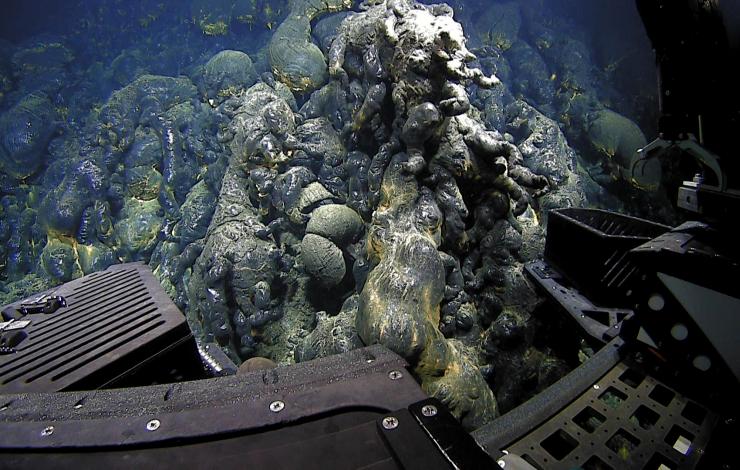
Results of the research documenting a recent volcanic eruption on the Mariana back-arc, 4500 meters deep, (making it the deepest known eruption on Earth) were published this week in a special issue of Frontiers in Earth Science (23 October 2018 | https://doi.org/10.3389/feart.2018.00172). It was first discovered in December of 2015 with cameras aboard an autonomous underwater vehicle, Sentry, by researchers searching for new hydrothermal vents. Bathymetric data also indicated major depth changes in the area collected between surveys in 2013 and 2015, were consistent with an eruption. The new lava flows stretched over an area about 4.5 miles long and ranged in thickness between 130 and 450 feet. Sentry’s 2015 photos revealed the presence of a pristine dark, glassy lava flow on the seafloor with no sediment cover. Images also showed venting of milky hydrothermal vent fluid indicating the lava flow was still warm, and therefore very young. By 2016 when scientists returned to the site in April and December with remotely operated vehicles Deep Discoverer and SuBastian, the observations showed a rapidly declining hydrothermal venting on the lava flows, suggesting the eruption had taken place only months before its discovery the previous year. These expeditions were conducted aboard the NOAA ship Okeanos Explorer and the research vessel, Falkor.
A marine geologist at NOAA’s Pacific Marine Environmental Laboratory and lead of the Earth-Ocean Interactions Program, who is lead author on the study, said “We know that most of the world’s volcanic activity actually takes place in the ocean, but most of it goes undetected and unseen.” In the last 30 years, scientists utilizing improving technology and exploration methods have detected evidence of about 40 undersea eruptions. Before 1990, there were zero. This research is important as undersea volcanoes can help inform us about how terrestrial volcanoes work and how they impact ocean chemistry, which can significantly affect local ecosystems.
The research was funded by the NOAA Office of Ocean Exploration and Research and NOAA’s Pacific Marine Environmental Laboratory, and was supported by the Schmidt Ocean Institute.
NOAA-PMEL-EOI Marianas Research:
https://www.pmel.noaa.gov/eoi/marianas_site.html
Press:
New York Times: A Vault of Glass and the Deepest Volcanic Eruption Ever Detected
OSU Press Release: Researchers discover deepest known underwater volcanic eruption
Earther: The Deepest Volcanic Eruption Ever Documented Left a Gnarly Sight on the Ocean Floor


